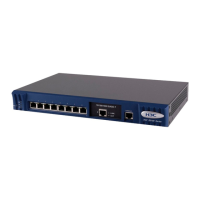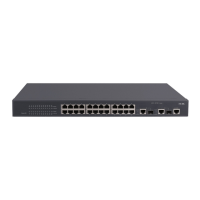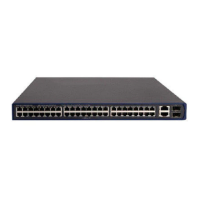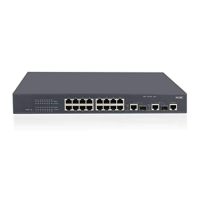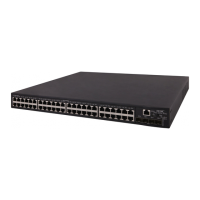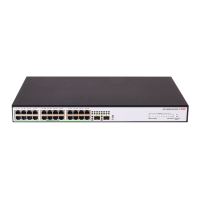1-35
mac-address: Link layer address in a static neighbor entry (48 bits long, in the format of H-H-H).
vlan-id: VLAN ID corresponding to a static neighbor entry, in the range of 1 to 4094.
port-type port-number: Ethernet port type and port number corresponding to a static neighbor entry.
interface-type interface-number: VLAN interface type and interface number corresponding to a static
neighbor entry.
Description
Use the ipv6 neighbor command to configure a static neighbor entry.
Use the undo ipv6 neighbor command to remove a static neighbor entry.
Note that:
You can configure a static neighbor entry in two ways:
z Mapping a VLAN interface to an IPv6 address and a link-layer address. The entry state is INCMP.
After the switch get the layer 2 port information of the VLAN, the neighbor entry enters the REACH
state.
z Mapping a Layer 2 port in a VLAN to an IPv6 address and a link-layer address. The Layer 2 port
specified by the port-type port-number argument must belong to the VLAN specified by the vlan-id
argument, and the corresponding VLAN interface must exist. After you carry out the command, the
device relates the VLAN interface to the IPv6 address to uniquely identify a static neighbor entry
which is in REACH state.
You only need to specify the corresponding VLAN interface when removing a static neighbor entry
related to that VLAN interface.
Related commands: display ipv6 neighbors.
Examples
# Configure a static neighbor entry for Ethernet 1/0/1 of VLAN 1.
<Sysname> system-view
System View: return to User View with Ctrl+Z.
[Sysname] ipv6 neighbor 2000::1 fe-e0-89 1 Ethernet 1/0/1
ipv6 neighbors max-learning-num
Syntax
ipv6 neighbors max-learning-num number
undo ipv6 neighbors max-learning-num
View
VLAN interface view
Parameters
number: Maximum number of neighbors that can be dynamically learned by an interface, in the range of
1 to 2048.
Description
Use the ipv6 neighbors max-learning-num command to configure the maximum number of neighbors
that can be dynamically learned on a specified interface.
Use the undo ipv6 neighbors max-learning-num command to restore the configuration to the default.
By default, the maximum number is 1024.
